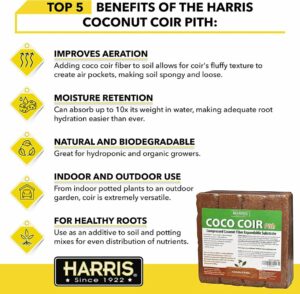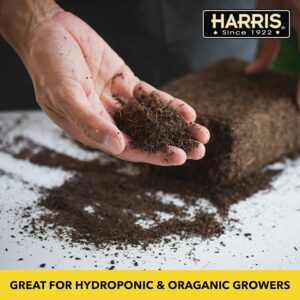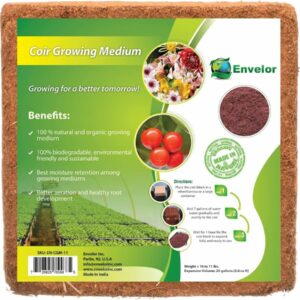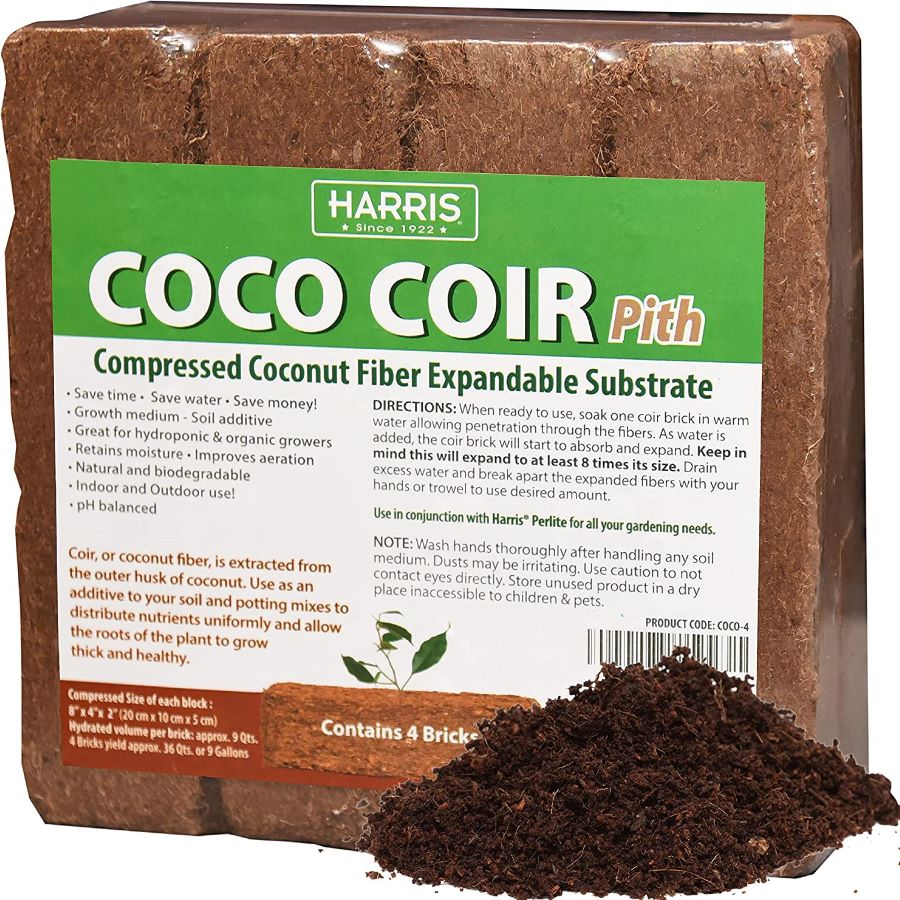Harnessing the Power of Coco Coir in Hydroponics: A Comprehensive Guide
Introduction
Hydroponics, a soil-less method of growing plants, has gained immense popularity recently due to its numerous benefits.
One crucial element in hydroponic systems is the choice of growing medium, which greatly impacts plant growth and overall success.
Coco coir has emerged as a favored option among hydroponic enthusiasts and commercial growers alike.
This comprehensive guide explores the power of coco coir in hydroponics and provides valuable insights for harnessing its potential.
Provo Green Products is your reliable source for discovering sustainable products that can positively impact your life and the environment.
With extensive experience in manufacturing, trades, and construction, Provo Green Products thoroughly researches each product before providing accurate and up-to-date information on its sustainability.
You can trust that you’re getting trustworthy insights to make informed choices whether you’re looking for solar products, electric bikes, eco-friendly products, renewable energy solutions, etc.
Provo Green Products is your go-to destination for finding the right green products for your lifestyle.
Disclosure: We may earn a small commission if you click on one of our links.
This does not affect the pricing of the product whatsoever.
Understanding Coco Coir: What Makes It Ideal for Hydroponics
Coco coir is a natural fiber derived from the husk of coconuts.
It has gained traction in hydroponics due to its exceptional properties.
First and foremost, coco coir exhibits excellent water retention capabilities while allowing for proper aeration, ensuring optimal plant moisture levels.
Additionally, coco coir has a neutral pH, providing a stable environment for nutrient absorption and preventing nutrient imbalances.
Its fibrous structure promotes strong root development, leading to healthier and more productive plants.
Coco Coir IS a Sustainable Choice in Hydroponics
In an era where sustainability is paramount, coco coir shines as an environmentally friendly option.
Coconut husks, which are used to extract coco coir, are a waste product from the coconut industry.
By repurposing this material, hydroponic growers contribute to reducing waste and utilizing renewable resources.
Moreover, coco coir is biodegradable, ensuring minimal environmental impact throughout its lifecycle.
Compared to other growing mediums, coco coir also minimizes water usage and nutrient leaching, making it an eco-conscious choice.

Coco Coir Preparation and Conditioning
Proper preparation and conditioning of coco coir are vital to maximizing its potential in hydroponics.
Before use, coco coir must be adequately hydrated and buffered to remove any excess salts or impurities.
This process ensures that the coco coir is clean, pH-stable, and ready to provide an optimal growing environment for plants.
A step-by-step guide on preparing and conditioning coco coir should include instructions on soaking, rinsing, and buffering techniques to achieve the desired results.
Choosing the Right Coco Coir for Hydroponics
When selecting coco coir for hydroponic applications, several factors come into play.
Different types of coco coir are available in the market, such as coco coir bricks, chips, and fiber.
Each variant has unique characteristics that make it suitable for specific crops or growing systems.
When choosing the right coco coir for their hydroponic setup, growers must consider factors such as water retention capacity, air porosity, and particle size.
Quality indicators, including color, texture, and absence of contaminants, should also be taken into account.
Setting up a Hydroponic System with Coco Coir
Integrating coco coir into a hydroponic system requires careful consideration of design and installation.
Depending on the crop and growth objectives, Coco coir can be used as a standalone growing medium or mixed with other materials.
When setting up a hydroponic system with coco coir, it is crucial to ensure proper drainage, aeration, and irrigation. Growers must also pay attention to container selection, irrigation methods, and the overall structural integrity of the system.
Maintaining the right moisture levels and pH balance in coco-coir-based systems is vital for optimal plant growth.

Nutrient Management in Coco Coir Hydroponics
Coco coir is an inert medium, meaning it does not contain significant nutrient content.
Therefore, proper nutrient management is essential in coco-coir-based hydroponic systems.
Growers must understand the specific nutrient requirements of their crops and provide a well-balanced nutrient solution accordingly.
Nutrient solutions can be prepared using commercial hydroponic fertilizers specifically formulated for coco coir or by customizing nutrient blends based on the crop’s needs.
Monitoring and adjusting nutrient levels in coco coir is crucial for maintaining plant health.
Regular monitoring of pH and electrical conductivity (EC) levels in the nutrient solution help ensure that plants receive the right balance of essential minerals.
pH levels should be within the appropriate range to facilitate optimal nutrient uptake, while EC levels indicate the concentration of nutrients in the solution.
Adjustments can be made by adding pH-up or pH-down solutions and adjusting the nutrient strength as necessary.
It’s important to note that coco coir has a high cation exchange capacity (CEC), which means it has the ability to retain and release nutrients over time.
This property allows for greater nutrient uptake efficiency and reduces the risk of nutrient leaching.
However, it also requires careful management to prevent nutrient imbalances or deficiencies.
Regular monitoring and periodic nutrient solution adjustments based on plant response and growth stage are essential for successful nutrient management in coco coir hydroponics.
Troubleshooting Common Issues in Coco Coir Hydroponics
Despite its many benefits, coco-coir hydroponics can present challenges that growers must address.
Nutrient imbalances, such as deficiencies or excesses, can occur due to improper nutrient management or fluctuations in pH and EC levels.
These imbalances can manifest as visible symptoms in plants, including stunted growth, yellowing leaves, or nutrient toxicity symptoms.
Growers can promptly identify and address these issues by closely monitoring plant health and nutrient levels.
Another common concern in coco-coir hydroponics is the potential for root diseases and pathogens.
Coco coir provides an excellent growing environment for roots but retains moisture, creating favorable conditions for pathogens to thrive.
To prevent root diseases, growers should ensure proper drainage, maintain adequate air circulation, and practice good sanitation measures.
Sterilizing coco coir before use and implementing a regular monitoring system for early detection of any signs of disease or pests is essential.
Managing excess salts is another aspect to consider in coco coir hydroponics.
Over time, salts can accumulate in the coco coir substrate, potentially leading to nutrient imbalances and reduced plant performance.
Flushing the coco coir periodically with plain water or a flushing solution helps remove excess salts and maintain a healthy root environment.
Care should be taken to balance the flushing process to avoid excessive leaching of nutrients.

Success Stories and Case Studies: Coco Coir Hydroponics in Action
Real-life examples and case studies provide valuable insights into the practical application of coco coir in hydroponic systems.
Numerous success stories demonstrate the effectiveness of coco coir in promoting robust plant growth, increased yields, and overall crop quality.
Case studies focused on specific crops, or commercial operations can highlight the advantages of using coco coir in hydroponics and provide inspiration for growers.
Lessons learned from experienced growers can also contribute to the body of knowledge surrounding coco coir hydroponics.
Sharing their experiences, techniques, and best practices can help new growers navigate the challenges and harness the full potential of coco coir as a hydroponic medium.
Embracing the Potential of Coco Coir in Hydroponics
Coco coir offers a range of benefits that make it an excellent choice for hydroponic cultivation.
Its water retention capacity, root-friendly structure, and neutral pH contribute to healthy plant growth and optimal nutrient uptake.
Additionally, coco coir is a sustainable and environmentally friendly option, making it attractive for growers seeking eco-conscious solutions.
By understanding the properties of coco coir, preparing it correctly, and managing nutrients effectively, hydroponic growers can harness its power and maximize crop yields.
Troubleshooting common issues, such as nutrient imbalances and root diseases, is crucial to maintaining the health and productivity of plants in coco-coir hydroponic systems.
As the popularity of coco coir in hydroponics continues to grow, success stories and case studies provide valuable insights and inspiration for novice and experienced growers.
These real-life examples showcase the tangible benefits of using coco coir, including increased yields, improved plant health, and enhanced crop quality.
By studying these success stories, growers can learn from the experiences and techniques of others, further refining their own practices and maximizing the potential of coco coir in their hydroponic operations.
Conclusion
Harnessing the power of coco coir in hydroponics offers numerous advantages for growers.
Its unique properties make it an ideal growing medium, promoting healthy plant development and providing a sustainable and environmentally friendly option.
By understanding coco coir, preparing it properly, managing nutrients effectively, and learning from the experiences of successful growers, hydroponic enthusiasts can confidently embrace the potential of coco coir and cultivate thriving plants in their hydroponic systems.
By integrating coco coir into their hydroponic practices, growers can take advantage of its unique properties to optimize plant growth, enhance sustainability, and achieve remarkable results.
Whether you’re a novice or an experienced grower, exploring the possibilities of coco coir in hydroponics is an exciting journey that can lead to healthier plants, higher yields, and a more sustainable approach to cultivation.
Embrace the power of coco coir in hydroponics and unlock its full potential in your own growing endeavors.
Stay in Touch!
I’am a dedicated entrepreneur with many years of experience and an integrity-driven individual who is highly motivated to succeed. Leveraging extensive expertise in manufacturing, construction, and various trades, we can provide a solid foundation for sustainable living. Our meticulous research process guarantees that our information about each product is precise and current, allowing you to make informed decisions. A deep understanding of business operations empowers me to consistently implement improvements that result in ongoing success. Visit site.

